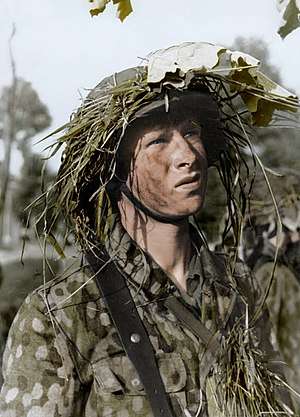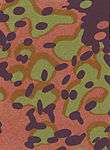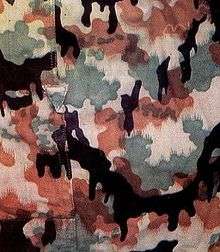German World War II camouflage patterns
German World War II camouflage patterns formed a family of disruptively patterned military camouflage designs for clothing, used and in the main designed during the Second World War. The first pattern, Splittertarnmuster ("splinter camouflage pattern"), was designed in 1931 and was initially intended for Zeltbahn shelter halves. The clothing patterns developed from it combined a pattern of interlocking irregular green, brown, and buff polygons with vertical "rain" streaks. Later patterns, all said to have been designed for the Waffen-SS by Johan Georg Otto Schick, evolved into more leaf-like forms with rounded dots or irregular shapes. Camouflage smocks were designed to be reversible, providing camouflage for two seasons, whether summer and autumn, or summer and winter (snow). Distribution was limited to the Waffen-SS, ostensibly because of a patent, though variants were used by other units, including the Luftwaffe. Production was limited by shortage of materials, especially of high quality waterproof cotton duck.[1]

The Reichswehr (Army of the Weimar Republic) started experimenting with camouflage patterns for Wehrmacht uniforms before World War II and some army units used Splittertarnmuster ("splinter camouflage pattern"), first issued in 1931, and based on Zeltbahn shelter halves/groundsheets. Waffen-SS combat units used various patterns from 1935 onwards. The SS camouflage patterns were designed by Johann Georg Otto Schick, a Munich art professor and then the director of the German camouflage research unit,[lower-alpha 2] at the request of an SS Major, Wim Brandt. Brandt was an engineer and the commander of the SS-VT reconnaissance battalion, and he was looking for better camouflage. Schick had researched the effect of light on trees in summer and in autumn. These led to the idea of reversible camouflage clothing, with green summer patterns on one side, brown autumn patterns on the other. In 1937, the patterns were field tested by the SS-VT Deutschland regiment, resulting in an estimate that they would cut casualties by fifteen percent.[lower-alpha 3] In 1938, a reversible spring/autumn helmet cover, smock, and sniper's face mask in Schick's forest patterns on waterproof cotton duck were patented for the Waffen-SS. The patent is said to have prevented the Wehrmacht from using the patterns, which became a distinctive emblem of the Waffen-SS during the war. However, patterned uniforms were worn by some other units, including from 1941 the Luftwaffe, which had its own version of Splittertarnmuster,[3] as well as the Kriegsmarine (navy), the Fallschirmjäger (paratroops), and the Waffen-SS.[4][5][6] The 1945 Leibermuster was planned to be issued to both the SS and the Wehrmacht, but it appeared too late to be widely distributed.[3]
Production of groundsheets, helmet covers and smocks by the Warei, Forster and Joring companies began in November 1938. They were initially hand-printed, limiting deliveries by January 1939 to only 8,400 groundsheets and 6,800 helmet covers and a small number of smocks. By June 1940, machine printing had taken over, and 33,000 smocks were made for the Waffen-SS. Supplies of high quality cotton duck, however, remained critically short throughout the war, and essentially ran out in January 1943. It was replaced by non-waterproof cotton drill cloth.[7][8]
Patterns
The German names used for the plane tree, palm and oak leaf patterns are not those that were used in the German armed forces, but were invented by postwar collectors of militaria.[4]
| German name | English name | Date | Image | Notes |
|---|---|---|---|---|
| Splittertarnmuster (Buntfarbenmuster) | Splinter pattern ("Colourful pattern") | 1931 | _(cropped).jpg) | The first German camouflage pattern, initially used for Zeltbahn groundsheets |
| Luftwaffen- Splittertarnmuster | Luftwaffe splinter pattern | 1941 | .jpg) | German air force variant Splittertarnmuster[3] |
| Platanenmuster | Plane tree pattern | 1937–1942 |   | Spring and autumn variations, first dotted camouflage pattern[1] |
| Rauchtarnmuster | Blurred Edge pattern | 1939–1944 | Summer and autumn variations[1] | |
| Palmenmuster | Palm tree pattern | 1941–? | Spring and autumn variations, used by Waffen-SS[1][4] | |
| Beringtes Eichenlaubmuster | Oak leaf pattern B | 1942–1945 | [1][4] | |
| Eichenlaubmuster | Oak leaf A | 1943–1945 | Spring and autumn variations, reversible Waffen-SS smocks Also for Zeltbahn tent sheets[1][4] | |
| Sumpftarnmuster | Swamp pattern | 1943 |  | Blurred and more saturated form of Splittertarnmuster; Summer/winter variations; Smocks reversible to snow camouflage[1][4] |
| Erbsenmuster | Pea dot pattern | 1944–1945 |  | Based on Eichenlaubmuster[1][4] |
| Leibermuster | (named after the Leiber brothers) | 1945 |  | Bold irregular pattern. Designed to absorb infra-red. Saw only limited usage.[1][4] Inspired postwar US ERDL pattern[9] |
See also
- Digital camouflage
- Flecktarn – post-World War II camouflage pattern used by the Bundeswehr
Notes
- Recoloured image
- Almost nothing is known about Schick beyond these bare facts. The film director Michael Madsen planned to make a film, The Black Forest, about Schick's shadowy life, but it has not appeared.[2]
- The methodology behind this claim is not known.
References
- Beaver & Borsarello 1995, p. 202.
- DFI 2003.
- Dougherty 2017, pp. 45–47.
- Newark 2007, pp. 133–137.
- Davis 1998.
- Wilkinson-Latham 2011.
- Mann 2014, p. 103.
- Ferguson & Lumsden 2009, p. 310.
- Richardson 1945.
Sources
- Beaver, Michael D.; Borsarello, J. F. (1995). Camouflage Uniforms of the Waffen-SS. Schiffer. ISBN 1-84176-854-5.CS1 maint: ref=harv (link)
- Davis, Brian L. (1998). German Army uniforms and insignia : 1933 - 1945. Brockhampton Press. ISBN 978-1-86019-869-4.CS1 maint: ref=harv (link)
- DFI (2003). "Michael Madsen born 1971 Documentaries". Danish Film Institute.
... 2003 ... IN DEVELOPMENT: ... The Black Forest. A film on dead angles & Modern Identity. The life's and disappearances of Professor Otto Schick, key German master camouflage inventor, WWII
CS1 maint: ref=harv (link) - Dougherty, Martin J. (2017). Camouflage At War: An Illustrated Guide from 1914 to the Present Day. Amber Books. ISBN 978-1-78274-498-6.CS1 maint: ref=harv (link)
- Ferguson, Robert; Lumsden, Robin (2009). Himmler's SS: Loyal to the Death's Head. History Press. ISBN 978-0-7524-9722-8.CS1 maint: ref=harv (link)
- Mann, Chris (2014). SS Totenkopf: The History of the 'Death's Head' Division 1940–45. Amber Books. ISBN 978-1-907446-87-0.CS1 maint: ref=harv (link)
- Newark, Tim (2007). Camouflage. Thames and Hudson. ISBN 978-0-500-51347-7.CS1 maint: ref=harv (link)
- Richardson, Francis (1945). Camouflage Fabrics both Plain and Printed for Military Use by the German SS and German Army.CS1 maint: ref=harv (link) Reprinted in: Borsarello, J.F. (Ed.) (1990). SS & Wehrmacht Camouflage, ISO Publications.
- Wilkinson-Latham, Ed (2011). "A Short History of Camouflage". Toronto Standard.CS1 maint: ref=harv (link)
Further reading
- Mollo, Andrew (1987). The Armed Forces of World War 2: Uniforms, Insignia and Organization. Little, Brown.
- Palinckx, Werner; Borsarello, J.F. (2002). Camouflage Uniforms of the German Wehrmacht. Schiffer.
- Peterson, Daniel (1998). Europa Militaria No 17: Wehrmacht Camouflage Uniforms and Post-War Derivatives. Crowood Press.
- Peterson, Daniel (2001). Europa Militaria No 18: Waffen SS Camouflage Uniforms and Post-War Derivatives. Crowood Press.
- Steven, Andrew; Amodio, Peter (1998). Europa Militaria No. 6: Waffen SS Uniforms in Colour Photographs. Crowood Press.
External links
- Germany - pre-1945 on Camopedia, illustrated
- Introduction to German World War 2 Patterns by Michael Farnworth, illustrated with photographs of patterns and equipment
.jpg)